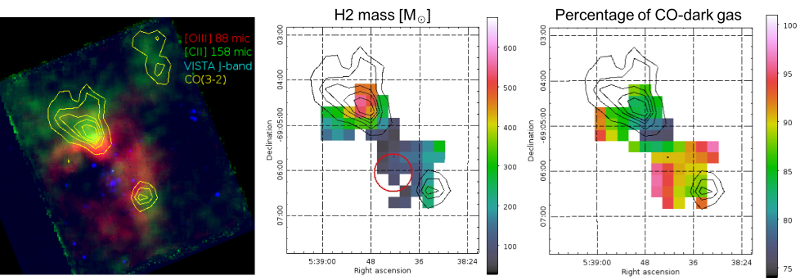
|
EPoS |
|
EPoS Contribution
|
|
A Dominant Reservoir of CO-Dark Molecular Gas in 30 Doradus - the Local Archetype of Extreme High-Mass Star-Forming Regions
Melanie Chevance ARI/ZAH, Heidelberg, DE | |
|
Star formation takes place in molecular clouds. However, the most abundant molecule in the ISM, H2, cannot be observed directly in the cold gas. CO line emission represents the most commonly used tracer of the molecular gas. However, the conversion factor from CO to H2 is environmentally dependent, as extragalactic observations showed it sensitive to metallicity and radiation field. This can be a concern specifically in high mass star forming regions, where H2 and CO respond differently to the ambient radiation field. I will present a thorough analysis of the 30 Doradus region in the Large Magellanic Cloud, which is the most extreme high-mass star-forming region in the nearby universe, and show that the total reservoir of molecular gas can be more than 10 times more massive than inferred through CO observations.
We have used the Herschel/PACS and SPIRE/FTS observations of FIR fine structure lines, combined with Spitzer/IRS spectroscopic maps to constrain the physical conditions in the photo-dissociation regions (PDRs) in 30 Doradus, using the Meudon PDR model, and to determine the total molecular gas mass reservoir present outside of the CO cores. We find that this "CO-dark gas" can represent more than 90% of the actual molecular gas reservoir in this extreme environment, due to the effect of the intense radiation field on the half-solar metallicity ISM. The high fraction of molecular gas undetected by CO is expected to affect all observations of high-mass star-forming regions. This has important implications for the inferred star formation efficiencies in these environments, the rate at which feedback from massive stars evaporate the reservoir of molecular gas, and the extent to which the associated shielding enable ongoing star formation in other parts of the cloud complex. | |
 | |
| Caption: Left: 3-color map of 30 Doradus showing the different layers of gas around R136 (stars seen with VISTA J-band, blue), from the ionized gas ([OIII], red) to the PDR ([CII], green) and to the molecular gas (CO, yellow contours). Center: Spatial distribution of the H2 mass predicted by our PDR modeling. Black contours show CO(3-2) intensity. Right: Percentage of CO-dark gas. Black contours show CO(3-2) intensity. A large fraction (90% on average, and always >75%) of the total reservoir of molecular gas is undetected through CO in this environment. | |
| Collaborators: S. Madden, CEA, FR D. Cormier, CEA, FR V. Lebouteiller, CEA, FR M.-Y. Lee, MPfIR, DE D. Kruijssen, ARI/ZAH, DE |
Key publication
Suggested Session: High-mass star/star cluster formation |